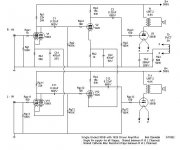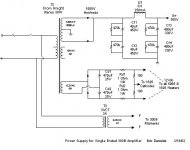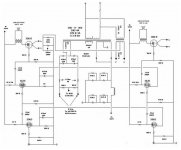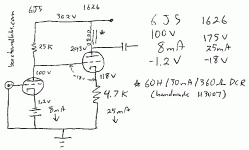1626 driver - neat
I just designed this direct-coupled 1626 driver for an amp I am building. Very similar to this design, but driver is direct coupled and choke loaded (use cheap 60H/30mA Handmade Electronics choke).
This should be a big bad driver stage - it could be a 1W amp all by itself. In fact, I plan to build it as a DC-Darling amp at some point.
I am using a 6sn7/6j5 as the input tube.
If you do this DC thing, use a 12vct filament transformer for each 1626 and connect the canter tap to the cathode to minimize filament-cathode potential, often a problem with DC designs.
jsn
I just designed this direct-coupled 1626 driver for an amp I am building. Very similar to this design, but driver is direct coupled and choke loaded (use cheap 60H/30mA Handmade Electronics choke).
This should be a big bad driver stage - it could be a 1W amp all by itself. In fact, I plan to build it as a DC-Darling amp at some point.
I am using a 6sn7/6j5 as the input tube.
If you do this DC thing, use a 12vct filament transformer for each 1626 and connect the canter tap to the cathode to minimize filament-cathode potential, often a problem with DC designs.
jsn
Attachments
2 things
2 things:
1) The values on the schematic you posted look correct. I didn't see any obvious errors.
2) I forgot to draw a grid resistor in the scematic I just posted. please use whatever your preamp wants (or a pot or whatever). 100k seems to be "standard".
I am working on a followup to my little "hi fi primer" that will show folks how to work through a direct-coupled design and will probably use this 6j5/6sn7-1626 amp as the example. I promise to build it and everythig to prove it works.
Check here for updates:
http://boozhoundlabs.com/
jsn
2 things:
1) The values on the schematic you posted look correct. I didn't see any obvious errors.
2) I forgot to draw a grid resistor in the scematic I just posted. please use whatever your preamp wants (or a pot or whatever). 100k seems to be "standard".
I am working on a followup to my little "hi fi primer" that will show folks how to work through a direct-coupled design and will probably use this 6j5/6sn7-1626 amp as the example. I promise to build it and everythig to prove it works.
Check here for updates:
http://boozhoundlabs.com/
jsn
kmtang said:4.8K impedance OPT seems too large for the 300B. I prefer running it with 2.5K to 3.5K.
If I use a lower K OPT @ which MA value do I use. The one in the schematic is 110MA.
The current through the out put transformer will be the same. The impedance listed is not DC Resistance, but the ac impedace presented to the 300b, determined by the ratio of primary and secondary windings and the load placed across the secondary - the speaker.
A higher impedance ususally results in lower distortion, and slightly less power.
jsn
A higher impedance ususally results in lower distortion, and slightly less power.
jsn
- Status
- This old topic is closed. If you want to reopen this topic, contact a moderator using the "Report Post" button.
- Home
- Amplifiers
- Tubes / Valves
- Please review schematic



